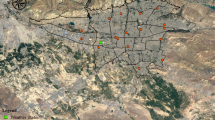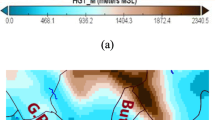Abstract
Air quality modelling can be a strong tool for air quality management. In the present study, the Danish Urban Background Model (UBM) and the USEPA AERMOD are applied for calculating NOx and total particulate matter (TPM) concentrations for Mumbai city of India for the years 2007 and 2012. In order to compare the results from the two models, two sets of simulations are performed using the same sets of input data for boundary conditions, emissions, and meteorology. The results showed that the NOx calculations from the UBM model were in better agreement with observed data when compared with similar results from the AERMOD model. However, the opposite was the case for TPM for which the results from the AERMOD model were in better agreement with observed data when compared with the results from the UBM. The concentration levels for 2012 were generally higher than for 2007, reflecting differences in meteorological conditions for the 2 years. When comparing the obtained model results with measurements, it should be noted, that the emission inventories have various shortcomings, and that the boundary conditions from the DEHM (Danish Eulerian Hemispheric Model) are obtained with a coarse resolution of 150 km × 150 km. One of the main shortcomings of the TPM emission inventories is that it is not accounted for all the sources. Moreover, for both TPM and NOx, the boundaries of model calculations of the UBM and AERMOD model domain are underestimating the actual concentrations due to the relatively coarse resolution. When the UBM model calculations are scaled to fit the level of the observed concentrations, it is evident that spatial and temporal variation reproduced better results when compared with the results obtained from AERMOD.












Similar content being viewed by others
References
ARAI. (2007). Emission factor development for Indian vehicles, air quality monitoring project-Indian clean air programme (ICAP). Pune: Automot. Res. Assoc.
Berkowicz, R. (2000). A simple model for urban background pollution. Env. Mon and Ass., 65, 259–267. https://doi.org/10.1023/A:1006466025186.
Bhagat, R. B., & Sita, K. (2012). Population change and economic restructuring in Mumbai. Mumbai: Urban Design Research Institute (UDRI) Link: http://www.udri.org/.
Brandt, J., Christensen, J. H., Frohn, L. M., Palmgren, F., Berkowicz, R., & Zlatev, Z. (2001a). Operational air pollution forecasts from European to local scale. Atmospheric Environment, 35(1), S91–S98.
Brandt, J., Christensen, J. H., Frohn, L. M., & Berkovicz, R. (2001b). Operational air pollution forecast from regional scale to urban street scale. Part 1: system description. Physics and Chemistry of the Earth (B), 26(10), 781–786.
Brandt, J., Christensen, J. H., & Frohn, L. M. (2001c). Operational air pollution forecast from regional scale to urban street scale. Part 2: performance evaluation. Physics and Chemistry of the Earth (B), 26(10), 825–830.
Brandt, J., Christensen, J. H., Frohn, L. M., & Berkowicz, R. (2003). Air pollution forecasting from regional to urban street scale–implementation and validation for two cities in Denmark. Physics and Chemistry of the Earth, 28, 335–344, 2003.
Brandt, J., Silver, J. D., Frohn, L. M., Geels, C., Gross, a., Hansen, a. B., Hansen, K. M., Hedegaard, G. B., Skjøth, C. a., Villadsen, H., Zare, a., & Christensen, J. H. (2012). An integrated model study for Europe and North America using the Danish Eulerian Hemispheric Model with focus on intercontinental transport of air pollution. Atmospheric Environment, 53, 156–176. https://doi.org/10.1016/j.atmosenv.2012.01.011.
Brandt, J., Silver, J. D., Christensen, J. H., Andersen, M. S., Bønløkke, J. H., Sigsgaard, T., Geels, C., Gross, a., Hansen, a. B., Hansen, K. M., Hedegaard, G. B., Kaas, E., & Frohn, L. M. (2013a). Assessment of past, present and future health-cost externalities of air pollution in Europe and the contribution from international ship traffic using the EVA model system. Atmospheric Chemistry and Physics, 13, 7747–7764. https://doi.org/10.5194/acp-13-7747-2013.
Brandt, J., Silver, J. D., Christensen, J. H., Andersen, M. S., Bønløkke, J. H., Sigsgaard, T., Geels, C., Gross, a., Hansen, a. B., Hansen, K. M., Hedegaard, G. B., Kaas, E., & Frohn, L. M. (2013b). Contribution from the ten major emission sectors in Europe and Denmark to the health-cost externalities of air pollution using the EVA model system—an integrated modelling approach. Atmospheric Chemistry and Physics, 13, 7725–7746. https://doi.org/10.5194/acp-13-7725-2013.
EPA (2004) AERMOD: description of model formulation, U.S. Environmental Protection Agency, Office of Air Quality Planning and Standards, Emissions Monitoring and Analysis Division, Research Triangle Park, North Carolina. EPA-454/R-03-004.
Fauser, P., Ketzel, M., Becker, T., Plejdrup, M. S., Brandt, J., Gidhagen, L., Omstedt, G., Skårman, T., Bartonova, A., Schwarze, P., Karvosenoja, N., Paunu, V.-V., Kukkonen, J., & Karppinen, A. (2017). Human exposure to carcinogens in ambient air in Denmark, Finland and Sweden. Atmospheric Environment., 167, 283–297. https://doi.org/10.1016/j.atmosenv.2017.08.033.
Frohn, L. M., Christensen, J. H., & Brandt, J. (2002). Development of a high resolution nested air pollution modelethe numerical approach. J. of Comp. Phy., 179, 68–94.
Geels, C., Doney, S. C., Dargaville, R., Brandt, J., & Christensen, J. H. (2004). Investigating the sources of synoptic variability in atmospheric CO2 measurements over the Northern Hemisphere continents: a regional model study. Tellus B, 56, 35–50.
Geels, C., Andersen, H. V., Ambelas Skjøth, C., Christensen, J. H., Ellermann, T., Løfstrøm, P., Gyldenkærne, S., Brandt, J., Hansen, K. M., Frohn, L. M., & Hertel, O. (2012a). Improved modelling of atmospheric ammonia over Denmark using the coupled modelling system DAMOS. Biogeosciences, 9, 2625–2647. https://doi.org/10.5194/bg-9-2625-2012.
Geels, C., Hansen, K. M., Christensen, J. H., Ambelas Skjøth, C., Ellermann, T., Hedegaard, G. B., Hertel, O., Frohn, L. M., Gross, a., & Brandt, J. (2012b). Projected change in atmospheric nitrogen deposition to the Baltic Sea towards 2020. Atmospheric Chemistry and Physics, 12, 2615–2629. https://doi.org/10.5194/acp-12-2615-2012.
Geels, C., Andersson, C., Hänninen, O., Lansø, A. S., Schwarze, P., & Brandt, J. (2015). Future premature mortality due to air pollution in Europe–sensitivity to changes in climate, anthropogenic emissions, population and building stock. International Journal of Environmental Research and Public Health, 12, 2837–2869. https://doi.org/10.3390/ijerph120302837.
Hedegaard, G. B., Christensen, J. H., Geels, C., Gross, A., Hansen, K. M., May, W., Zare, A., & Brandt, J. (2012). Effects of changed climate conditions on tropospheric ozone over three centuries. Atmospheric and Climate Sciences, 2(4), 546–561. http://www.scirp.org/journal/acs/. https://doi.org/10.4236/acs.2012.24050.
Hedegaard, G. B., Christensen, J. H., & Brandt, J. (2013). 2013: “The relative importance of impacts from climate change vs. emissions change on air pollution levels in the 21st century”. Atmospheric Chemistry and Physics, 13, 3569–3585. https://doi.org/10.5194/acp-13-3569-2013.
Hertel, O., & Berkowicz, R. (1990). Beregning af NO2-koncentrationer i byområder i forbindelse med varsling af forureningsepisoder (with English Summary). DMU Luft, A-139, 43.
Hertel, O., Ellermann, T., Palmgren, F., Berkowicz, R., Løfstrøm, P., Frohn, L. M., Geels, C., Skjøth, C. A., Brandt, J., Christensen, J., Kemp, K., & Ketzel, M. (2007). Integrated air quality monitoring—combined use of measurements and models in monitoring programmes. Environment and Chemistry, 2007(4), 65–74. https://doi.org/10.1071/EN06077.
Kesarkar, A. P., Dalvi, M., Kaginalkar, A., & Ojha, A. (2006). Coupling of the weather research forecasting model with AERMOD for pollutant dispersion modelling. A case study for PM10 dispersion over the Pune city. Atmospheric Environment, 41, 1976–1988.
Kumar, A., Dikshit, A., Fatima, S., & Patil, R. (2015). Application of WRF model for vehicular pollution modelling using AERMOD. Atmospheric and Climate Sciences, 5, 57–62. https://doi.org/10.4236/acs.2015.52004.
Kumar, A., Patil, R. S., Dikshit, A. K., & Kumar, R. (2016a). Comparison of predicted vehicular pollution concentration with air quality standards for different time periods. Clean Technology and Environmental Policy, 18, 2293–2303. https://doi.org/10.1007/s10098-016-1147-6.
Kumar, A., Patil, R. S., Dikshit, A. K., Islam, S., & Kumar, R. (2016b). Evaluation of control strategies for industrial air pollution sources using AERMOD with simulated meteorology by weather research and forecasting model. Journal of Cleaner Production, 116, 110–117.
Kumar, A., Ketzel, M., Patil, R. S., Dikshit, A. K., & Hertel, O. (2016c). Vehicular pollution modelling using operational street pollution model (OSPM) for Chembur, Mumbai (India). Environment Monitoring and Assessment, 188, 349. https://doi.org/10.1007/s10661-016-5337-9.
Mohan, M., Bhari, S., Sreenivas, A., & Marrapu, P. (2011). Performance evaluation of AERMOD and ADMS-urban for total suspended particulate matter concentrations in megacity Delhi. Aerosol and Air Quality Research, 11, 883–894.
MVD. (2011). Motor transport statistics of Maharashtra 2010–2011. Maharashtra: Motor Vehicle Department.
MVD. (2013). Motor transport statistics of Maharashtra 2012–2013. Maharashtra: Motor Vehicle Department.
NEERI. (2010). Air quality assessment, emissions inventory and source apportionment studies: Mumbai. Mumbai: CPCB Project.
Olesen, H.R., Brown, N. (1988). The OML meteorological preprocessor—a software package for preparation of meteorological data for dispersion models. MST Luft A122.
Rood, A. S. 2014. Performance evaluation of AERMOD, CALPUFF, and legacy air dispersion models using the Winter Validation Tracer Study Dataset. Atmospheric Environment. 89. Elsevier Ltd: 707–720.
Author information
Authors and Affiliations
Corresponding author
Rights and permissions
About this article
Cite this article
Kumar, A., Brandt, J., Ketzel, M. et al. Evaluation of the Urban Background Model (UBM) and AERMOD for Mumbai City. Environ Model Assess 24, 75–86 (2019). https://doi.org/10.1007/s10666-018-9607-5
Received:
Accepted:
Published:
Issue Date:
DOI: https://doi.org/10.1007/s10666-018-9607-5




